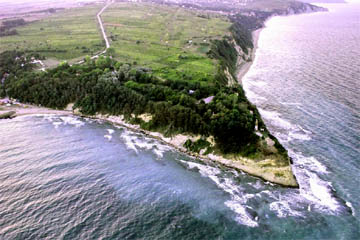The Military Mind
It seems that military minds think alike, no matter what the weapons or the period.
Until recently there was a Bulgarian army base on the St Antanas Cape, sited there because the position gave soldiers an excellent view up and down the coast as well as out to sea. It is not clear what they were worried about - the only powers with access to the Black Sea were the Russians, nominally friends, and the Turks, who were highly unlikely to mount a sea-borne invasion of Bulgaria when the land border was so conveniently to hand. Nevertheless the army jealously preserved its toe-hold on the prime location and scowling soldiers armed with AK-47s stared through binoculars at holiday makers on the long curving beach to the south, alert for possible hordes of NATO warriors infiltrating the people's republic disguised in bikinis and baggy trunks.

|
| An aerial view of Cape St Antanas south of Byzala on the coast of the Black Sea. |
With the fall of communism such paranoia became increasingly unpopular and expensive and a few years ago the army closed down the base and redeployed its conscripts to something more useful, if less picturesque. Tourists and holiday-makers could now wander the length of the beach without encountering barbed wire entanglements and humourless guards. Alas, wherever you have tourists you have property developers and the authorities in the nearby town of Byala have been swamped by applications to build tower block holiday appartments and multi-storey hotels all along the coast.
Unfortunately for the developers, there was a report of ancient remains on the cape. Hermingild and Karel Skorpil, brothers who virtually founded Bulgarian archaeology, had explored the area back in 1892 and their report was confirmed by a short expedition in the 1970s. Some claimed that the ruins were linked to a fortress called Larisa mentioned by Strabo. Equally unfortunate was the fact that Byala mayor, Anastas Trendafilov, takes his responsibilities seriously and instead of turning a blind eye to the ancient remains and accepting the kickbacks offered by the property developers, he called in the archaeologists.
A team from Varna Archaeology Museum led by Professor Valeri Yotov duly arrived in the middle of July and began to explore the site. Although most of their time has been devoted to clearing and mapping, they have also done some excavating and have confirmed that the remains date to the Byzantine era and the reigns of the emperors Anastasius I and Justinian I - in other words, between AD 491 and 565.
At this time attacks by pirates and barbarians were a serious threat and the fortress served a very useful purpose in protecting the coast from rapine and pillage. There is evidence of a rampart specifically designed to protect the fort against attack from the beach, indicating that the threat of sea-borne raiders was a serious one.
Dr Yotov's team has done some digging on the site of the most prominent ruins within the fortress, perhaps expecting that they would uncover the headquarters building. Instead the ruins turned out to be a Byzantine basilica.
© Kendall K. Down 2009





